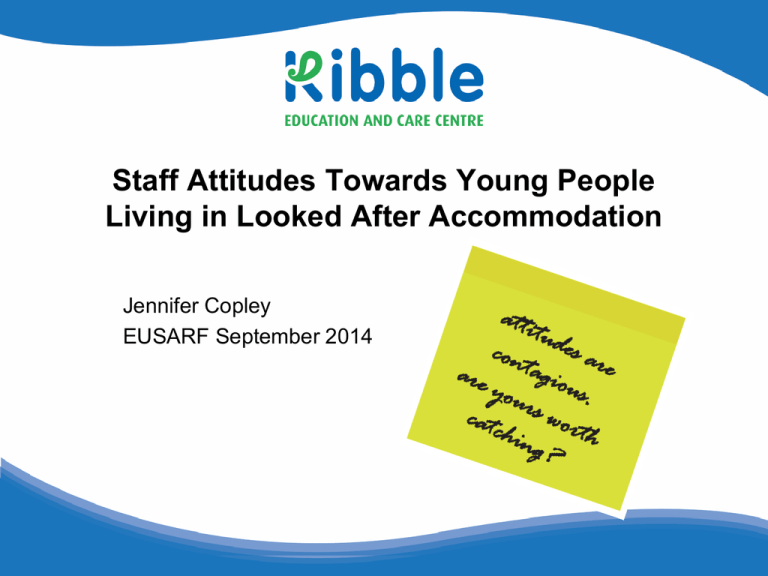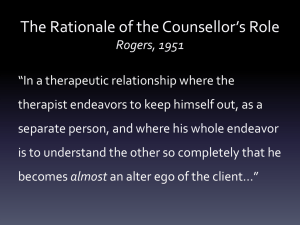
Staff Attitudes Towards Young People
Living in Looked After Accommodation
Jennifer Copley
EUSARF September 2014
Objectives
• Outline the aims of research project
• Discuss the research findings
• Consider practical application of the research
considerations
Copley, J., Johnson, D., and Bain, S. (in press). Staff attitudes towards young
people in looked after accommodation. Journal of Forensic Practice
Introduction
• Education and residential, secure and foster placements for young
people, male and female
• May experience a range of difficulties, including mental health
difficulties, self-harming behaviours, or involvement in offending and
substances misuse
• These characteristics can attractive negative attitudes from public
and staff members (Colton and Roberts, 2006)
Why consider staff attitudes?
• Important aspect of client facing roles
• May affect their working practice (Craig 2005; Lea et al,1999)
• Young people feel staff attitudes impact on their well-being (Stevens
and Boyle, nd)
Factors impacting on attitudes
•
Burnout
- a framework for considering the development of negative attitudes
towards clients
- notes the demands of client facing roles can leave staff feeling
emotionally exhausted, which can lead to the development of cynicism
and negative attitudes (Maslach and Jackson, 1981)
- some difficulties regarding measurement of burnout, but the model
suggests a link between staff well-being and the development of
negative attitudes
- Studies have considered the factors impacting on staff well-being; this
has included age, gender, exposure to violence, and organisational
factors
• This study focused on further individual characteristics that may
impact on psychological well-being, and therefore attitudes,
specifically empathy and coping style
• Empathy
- has been found to leave staff vulnerable to burn out (Regehr, et
al, 2002)
- considered a necessary characteristic for working in client facing
roles (Marshall, et al, 2005)
- emotional empathy: concerned with the feelings experienced
towards another person and linked to increasing risk of damage
to psychological well-being (Walker, 2011)
- cognitive empathy: ability to perspective take and consider views
of others while remaining detached, which can protect against
damage to psychological well-being (Gerdes and Segal, 2009)
• Coping Style
- how an individual copes with perceived threat (Roger at al, 1993)
- emotional coping: describes tendency to ruminate on emotionally
upsetting events, which may increase risk of psychological
distress or burnout (Roger and Jamieson, 1988)
- rational coping: defined by feeling independent of the problem
and found to be positively correlated with psychological wellbeing (Ireland et al, 2005)
Research hypothesis
• Psychological well-being, empathy (emotional and detached) and
coping style (affective and cognitive) would predict attitudes towards
young people
• Low psychological well-being, emotional empathy and emotional
coping would correlate negatively with attitudes
• Cognitive empathy and rational coping would correlate positively
with attitudes
Current study
• 83 Education and care staff
• Completed four questionnaires
-
Attitude to prisoner scale (adapted from Melvin et al, 1985)
The General Health Questionnaire (Goldberg and Williams, 2006)
Interpersonal Reactivity Index (Davis, 1980)
Coping Styles Questionnaire (Roger, et al, 1993)
• Used multiple regression to consider the power of each variable in
predicting attitudes
Research Findings
• Only factor predictive of staff attitudes was emotional empathy
• And in opposite direction to predicted
As emotional empathy went up, positive attitudes went up
What does this mean
• Original model proposed is unsupported (possibly not relevant to
this population)
• Emotional empathy may protect against development of negative
attitudes
• Importance of fostering staff empathy
Practical applications
• Consider empathy training
- empathy training has been demonstrated to increase patient
care with junior doctors (Riess et al., 2012) and a similar
recommendation has been made for prison staff (Ireland and
Quinn, 2007)
• Consider empathy within supervision
- open discussion about feelings towards young people
- understand the impact this work can have on attitudes
• Consider empathy during recruitment
- use of psychometric measures?
Limitations
• Only 34% of population responded, why they may have responded
• Cross-sectional study, using self-report at one establishment, limits
in determining causal direction
• Socially desirable responding (may reflect self awareness of
empathic feelings and desire not to present negative attitudes)
• Use of psychometrics to measure empathy: there is a range of tools,
possibly consider other methods
Thank you for your attention
Jen.Copley@kibble.org
References
Brewer, E.W. and Shapard, L. (2004). Employee Burnout: A Meta Analysis of the Relationship Between Age or Years
of Experience. Human Resource Development Review 3, 102-123.
Clarke, J. (2004). The Psycho-social Impact of working therapeutically with Sex Offenders: an Experimental study.
(Unpublished PhD Thesis). University of York
Colton, M., and Roberts, S. (2006). Factors that contribute to high turnover among residential child care staff. Child and
Family Social Work, 12(2), 133–142
Craig, L. A. (2005). The impact of training on attitudes towards sex offenders. Journal of Sexual Aggression, 11(2), 197207. doi.org/10.1080/13552600500172103
Gerdes, K.E.and Segal, E.A. (2009) A Social Work Model of Empathy. Advances in Social Work, 10 (2), 114-127
Hatcher, R. and Noakes, S. (2010). Working with sex offenders: the impact on Australian treatment providers.
Psychology, Crime and Law, 16(1-2), 145-167
Ireland, J.L., Boustead, R., and Ireland, C.A. (2005). Coping Style and Psychological Health among adolescent
prisoners: a study of young and juvenile offenders. Journal of Adolescence, 28, 411-423
Ireland, J. L., and Quinn, K. (2007) Officer Attitudes Towards Adult Male Prisoners Who Self Harm: Development of an
Attitudinal measure and Investigation of Sex Differences. Aggressive Behaviour, 33, 63-72
Lea, S., Auburn, T., and Kibblewhite, K. (1999). Working with Sex Offenders: The Perceptions and Experiences of
Professionals and Paraprofessionals. International Journal of Offender Therapy and Comparative
Criminology, 43, 103-119
Marshall, W.L., Ward, T., Mann, R.E., Moulden, H., Fernandez, Y.M., Serran. G., and Marshall, L.E. (2005). Working
Positively with Sexual offenders: Maximising the Effectiveness of Treatment. Journal of Interpersonal
Violence, 20, 1096-1114
Maslach, C., and Jackson, S. E. (1981). The measurement of experienced burnout. Journal of Occupation Behaviour,
2, 99-113
Regehr, C., Goldberg, G., and Hughes, J. (2002). Exposure to Human Tragedy, Empathy and Trauma in Ambulance
Paramedics. American Journal of Orthopsychiatry, 72(4), 505-513. DO1 10.1037//ooO2-9432.72.4.50
Riess, H., Kelley, J.M., Bailey, R.W., Dunn, E.J. and Phillips, M. (2012). Empathy Training for Resident Physicians: A
Randomized Controlled Trial of a Neuroscience-Informed Curriculum. Journal of General Internal
Medicine, 27(10), 1280-1286
Roger, D. and Jamieson, J. (1988). Individual differences in delayed heart-rate recovery following stress: The role of
extraversion, neuroticism and emotional control. Personality and Individual Differences, 9, 721-726
Roger, D., Jarvis, G., and Najarian, B. (1993). Detachment and coping: The construction and validation of a new scale
for measuring coping strategies. Personality and Individual Differences, 15(6), 619–626
Stevens, L and Boyle, P. (nd) The National Care Standards: hearing the voices of young people in residential care.
Available at http://www.celcis.org/media/resources/publications/National-Care-Standards-irenestevens.pdf.(March, 2013)
Walker, A.L., (2011). Working with sex offenders and those individuals with a learning disability: The importance of
psychological factors in the delivery of care. (Unpublished doctoral dissertation). University of
Birmingham. Available at http://etheses.bham.ac.uk/3156/1/Walker11ClinPsyD1.pdf (November, 2012)










